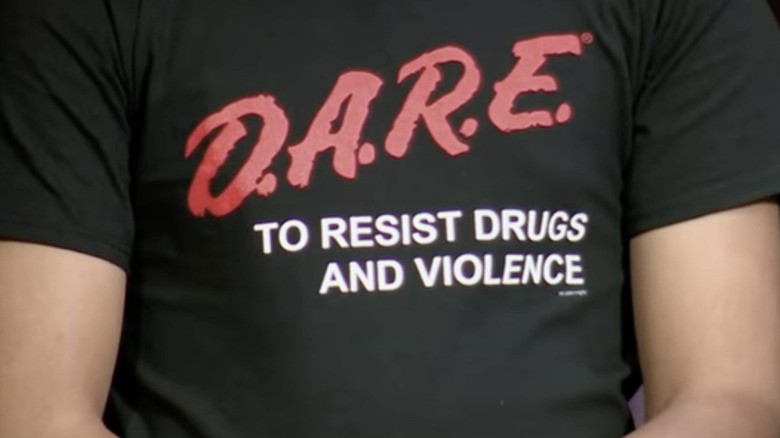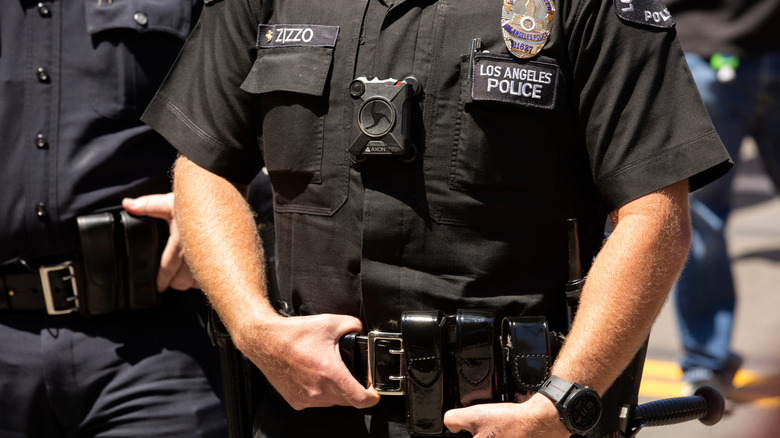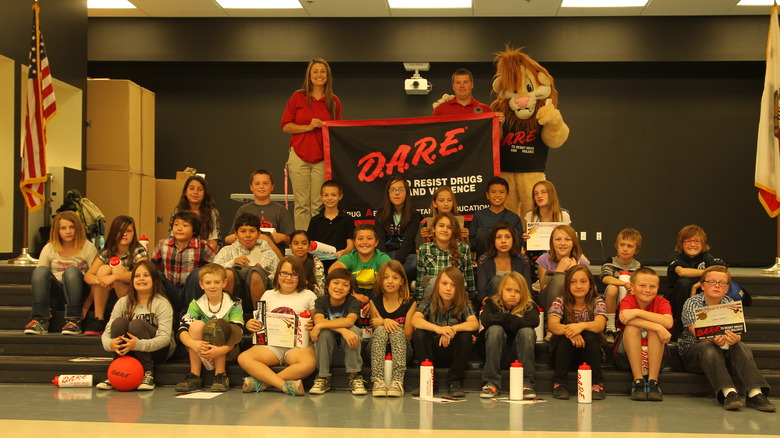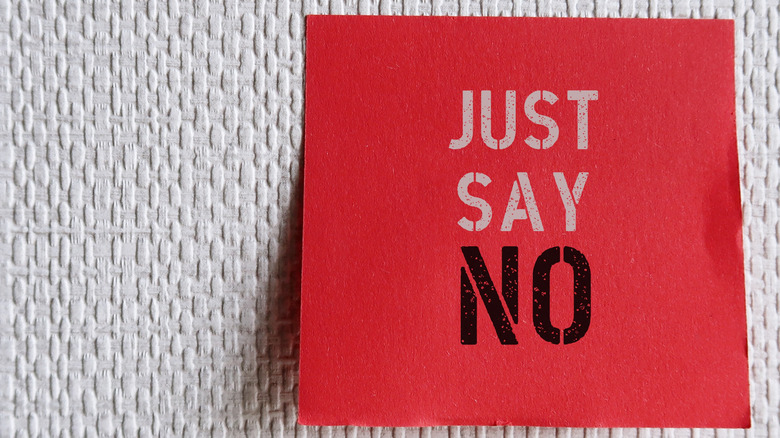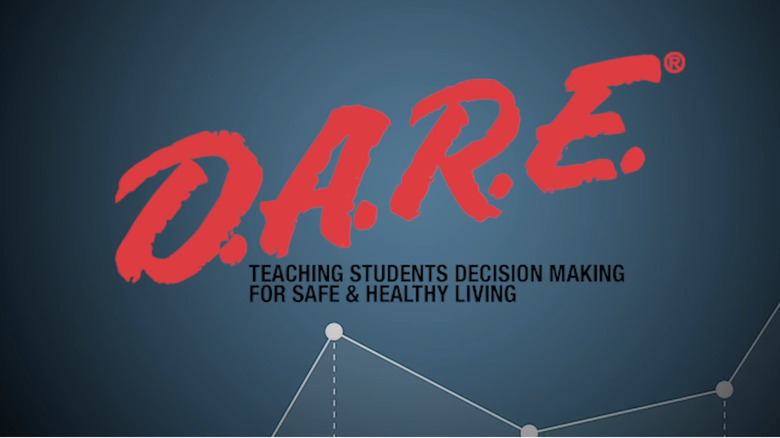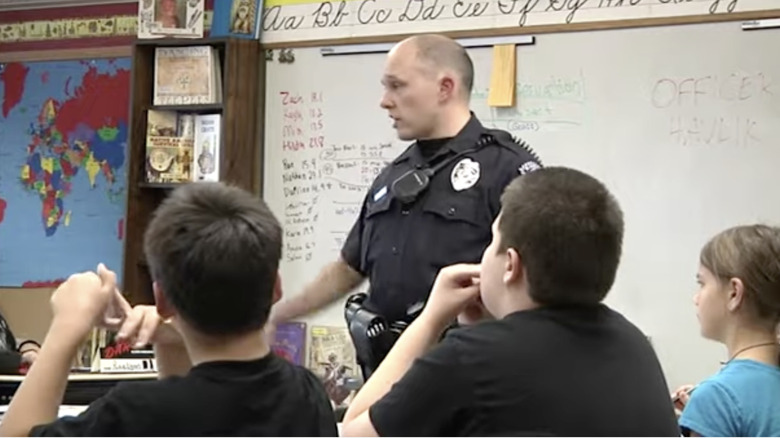The Controversial History Of D.A.R.E.
Many people who attended elementary and middle school in the 1980s and 1990s in the United States participated in the Drug Abuse Resistance Education (D.A.R.E.) program, per American Addiction Centers. It represented the kiddie-version of the United States' "War on Drugs" and became the educational standard for the next 15 years. Considered a hallmark feature of the public-school experience, the program enjoyed whole-hearted support by the early 1990s, earning corporate sponsors and advocates among politicians, teachers, parents, and students alike.
From t-shirts for graduates to a catchy theme song, it represented a social phenomena designed to right the social wrongs facing youth of the day. But in a world where latchkey kids and broken homes became the new norm (via CNN), the program may have tried to fill too many gaps. At its height, 75% of all students in the country received visits from local law enforcement who walked them through the steps of staying drug safe and not giving in to peer pressure. The program cost taxpayers countless millions of dollars each year, but Americans generally felt it was worth it. After all, children were the future, so providing them with a leg up in the drug war represented a worthy investment.
Clearly, everyone was onboard when it came to the D.A.R.E. program. There was just one minor problem: It didn't work. Keep reading to learn more about the controversial history of D.A.R.E., why it failed, and what the curriculum looks like today.
Created in Los Angeles
The Los Angeles Police Department pioneered the Drug Abuse Resistance Education (D.A.R.E.) program in cooperation with the Los Angeles Unified School District in 1983, per the Los Angeles Times. From its inception, the program received support and criticism, although the favorable reception far outweighed the voices of critics, according to the Public Broadcasting Service (PBS).
Supporters lauded it as a prime example of community-centered policing, and Los Angeles Police Chief Willie L. Williams praised it. But critics of the program remained skeptical about having police officers deliver what some felt was a curriculum plagued by flawed psychological methods. Despite some initial controversy, though, the D.A.R.E. program enjoyed bipartisan support in Congress. Soon, a small program started in SoCal spread nationally and internationally. By 1993, the program boasted a presence in 5,200 communities from coast-to-coast and all 50 states. Millions of kids went through the course each year, becoming acquainted with local law enforcement in the process.
But by 1993, the future of the program proved uncertain in Los Angeles for various reasons. Program officials wrestled with insufficient staffing, dropping from 100 officers initially dedicated to the program to 92 by 1993. And only 65 of these officers worked with the program in a full-time capacity. The decrease in officer participation stemmed from staffing and money shortages. As Los Angeles' population increased and a greater number of officers were needed on patrol, other programs got raided, including D.A.R.E.
Hundreds of millions of dollars poured into the program
Millions of children went through D.A.R.E. over the years, and law enforcement and politicians patted themselves on the back for the efforts the program made to keep kids on the straight and narrow, as reported by PBS. Unlike many other areas of education, the D.A.R.E. program enjoyed bipartisan support in Congress (via the Los Angeles Times) and among celebrities, school officials, and parents. Money and good intentions poured into the program.
But a look at the aftermath of the program looks bleak. Today, drug abuse remains a significant problem in the United States despite the focus on education and spending per student. Deaths due to drug overdose since 2000 are pushing 1 million, and more than 37 million Americans admitted to using illegal drugs within the last 30 days of 2020, according to the National Center for Drug Abuse Statistics. Not really the stats D.A.R.E. program officials had hoped for. But the bad news about the D.A.R.E. program didn't end there.
Over the years, numerous independent studies demonstrated that the program did little to thwart experimentation with alcohol, cigarettes, and illicit drugs. Sadly, despite the hundreds of millions of dollars poured into the program, the data didn't support the effort a decade later. Despite the reality of the numbers, however, D.A.R.E. kept chugging, fueled by taxpayer funds and private donors.
D.A.R.E. released a supplemental book
Although pairing police officers with elementary and middle schools has remained the most publicized aspect of the D.A.R.E. program, officials also supplemented courses with additional resources (via PBS). Glenn Levant wrote and published the book "Keeping Kids Drug Free" in 1998. As D.A.R.E.'s founding director and president, Levant longed for a drug-free future, and he actively promoted his work as a supplement parents needed in their homes.
Levant's book took the best from the D.A.R.E. curriculum and transformed it into a usable manual for parents. Many people lauded it as the best way for parents to meaningfully engage with kids about drugs. The book included a slang glossary of 2,000 terms to assist moms and dads in talking with their children and a questionnaire designed to identify red flags. But critics argued the book felt out of touch with reality and did more to excite hysteria than assist families in confronting the challenges of peer pressure and growing up.
In one instance, the questionnaire was administered to a group of 30 seventh graders. Of those tested, 29 ranked in the so-called "danger zone." In the context of the scare tactics employed by the D.A.R.E. program historically, the results didn't surprise anyone. After all, a central tenet of the program involved convincing kids (and their parents) that every child was a drug user just waiting to happen.
D.A.R.E. came out of the 'Just Say No' campaign
By 1985, cocaine use had increased in America from 4.2 million to 5.8 million, and two years later, crack proved widely available in all but four states, according to History. What's more, drug-related emergency room (ER) visits shot up four times from 1984 to 1987. As a part of the government's attempt to counter this social nightmare, First Lady Nancy Reagan spearheaded the "Just Say No" campaign, designed to help kids overcome the peer pressure fueling drug use, as reported by American Addiction Center.
Reagan worked tirelessly to promote the program, appearing on talk shows and public service announcements across the United States. She toured drug rehabilitation centers to the flash of cameras and buzz of journalists, providing catchy sound bites about "Just Say No." Into this climate, the D.A.R.E. program was birthed, providing wraparound education for school-aged children in conjunction with learning to utter that powerful two-letter word "no."
As a byproduct of the "Just Say No" campaign and the large "War on Drugs" launched by America in the 1980s, D.A.R.E. marked a veritable time capsule — one jam-packed with the drug-related hysteria drowning the nation in the 1980s and 1990s as crack, a cheap form of cocaine, hit the streets of America in a big way.
D.A.R.E. data showed it didn't work
Despite the public and private financial support the program enjoyed over the years, a persistent and inescapable fact dogged it: data demonstrated it didn't work. According to PBS, more than 12 independent studies showed that graduates of D.A.R.E. proved as likely to dabble in illicit drugs as their non-D.A.R.E. counterparts. The National Institute of Justice tried to downplay the results, stating, "The original D.A.R.E. core curriculum has been less successful than interactive programs in accomplishing its mission to prevent drug use among 5th- and 6th-grade pupils."
But some studies have proven downright damning of the program, pointing to the original curriculum's negative impacts on youth (via TIME). One study revealed that 20 year olds who participated in D.A.R.E. a decade earlier had lower self-esteem than their peers. Some believe these research findings point to the toll the scare tactics of the program took on kids by convincing them their peers were drug-addled delinquents waiting to destroy their lives through peer pressure.
Another study indicated that high school participants in the program were actually more likely to use drugs than their non-D.A.R.E. counterparts, per Vox. Researchers hypothesize the program inadvertently increases curiosity about drugs while normalizing their use. Apparently, when kids assume their peers are drug users, they experiment more, too. Despite the troubling findings, D.A.R.E. continued with little oversight. Even worse, supporters of the program attempted to suppress data and silence their critics.
The wrong tactics and audience
Critics of D.A.R.E. also claimed the program took place too young — fifth and sixth grade — while most adolescents didn't deal with drug issues until middle or high school (via PBS). Delbert Elliott of the University of Colorado analyzed 400 different anti-violence and anti-drug programs. After completing his research, he concluded that the D.A.R.E. program was "poorly timed." Elliott argued that children received the information prematurely, hampering the effectiveness of the lessons.
Elliott's findings brought critics out of the woodwork, including Richard Moran, a professor at Mount Holyoke College in Massachusetts. After examining more studies with similar results, Moran didn't mince words, concluding D.A.R.E. is "the biggest fraud in America." Other researchers proved more tactful with their wording, but they similarly concluded that the program as first conceived did little (except maybe make law enforcement, politicians, and school officials feel good).
In response to these charges, the D.A.R.E. program's curriculum has undergone significant revisions. D.A.R.E. officials have attempted to remove the scare tactics and provide a more comprehensive curriculum based on the many issues preteens and teens face. As reported by TIME, "The weakness in the old D.A.R.E. program ... was the simplicity of its message — and its panic-level assertions that 'drug abuse is everywhere.'" This hyperbolic message alienated students while making drug use appear more mainstream than it was. Today's D.A.R.E. advocates have worked hard to correct this.
Many teens saw right through it
As researchers took a long, hard look at the D.A.R.E. curriculum and identified some of its most egregious problems, they also found accuracy and authenticity issues, according to Vox. Apart from the immature audience and scare tactics, the material contained plenty of exaggerations that teens could identify and see right through. This proved especially true when it came to the presentation of facts about marijuana.
Not only did the D.A.R.E. program use hyperbolic language to steer kids clear of this substance, but the "fact sheet" associated with it claimed that marijuana had no medical uses. Such arguments were highly controversial and disputed by countless health experts. In other words, it was the wrong hill for D.A.R.E. officials to choose to die on. But they made it far worse by including other information that wasn't necessarily true, too.
As Michael Slater of Ohio State University explains, "Especially with teens, you've got to be credible. They've got great BS thermometers." As teens came to doubt the program's take on substances like marijuana, they doubted the program's entire message. The unfortunate natural conclusion for many was throwing the baby out with the bath water. Coupled with the program's tendency to normalize drug use, this explains why an anti-drug program like D.A.R.E. ended up having the opposite effect (via TIME).
The messenger may have been the problem
Some researchers believe another failing of the D.A.R.E. program had to do with the messenger, per Landmark Recovery. Although D.A.R.E. claimed to help students avoid peer pressure, build self-esteem, and say no to drugs, its presentation by law enforcement proved problematic for various reasons. Instead of having law enforcement instructors, they argued addiction prevention specialists should've been at schools. Some also suggested recovering addicts might participate in school visits for Q&As and discussions.
Nevertheless, because of its law enforcement origins, police officers have remained active in the program throughout its history. As a result, it has focused on "a punitive, zero-tolerance approach to drugs rather than adopting an educational and rehabilitative view." On top of this, not all people perceive police officers the same way. Some have warm, fuzzy feelings while others respond to them very differently. Students who perceived law enforcement as oppositional forces had trouble absorbing the takeaway points of the curriculum. Such issues would've been mitigated by an addiction prevention specialist or recovering addict.
D.A.R.E. also encouraged children to report anonymously about drugs encountered at school or home. The original program involved placing a box in the classroom where these anonymous tips got dropped. Such an atmosphere might have bred suspicion and lack of trust for kids at home and in school. You could argue such tactics had the potential of destroying families from the inside out.
Data suppression and vilification of critics
Despite the shortcomings associated with the D.A.R.E. program, public support remained high. According to PBS, some officials involved with the program sought to vilify the curriculum's critics as drug legalization advocates. They also went after the growing body of scientific research with the aim of suppressing it. Eventually, they ignored the studies altogether.
Such tactics cast officials and supporters of the program in an increasingly negative light. Yet, when asked to show data supporting the success of D.A.R.E., there remained a significant dearth. This lack of data in support of the program pointed to an increasing gulf between the program's prevalence and popularity and its measurable influence on adolescent behavior (via The Washington Post).
In response to detractors of D.A.R.E., program officials have denounced the scientific data. They've also shot back with vitriolic rhetoric: "Our detractors like to characterize D.A.R.E. as an 'Orwellian reality' or 'Big Brother's at work.' These bush-league tactics are transparent for what they are: attempts to support various individual personal agendas at the expense of our children" (via Alcohol Facts). Supporters of D.A.R.E. have proven steadfast, and the program has adopted a stop-gap defensive argument over the years, claiming that if even one child is deterred from using drugs it's worth it. While no one wants to condemn a child to falling through the cracks, detractors of D.A.R.E. say the effort and money spent on the program should produce verifiable and demonstrable results.
The program got a redesign
In 2001, officials revamped the D.A.R.E. program, reworking it to remedy past weaknesses, per TIME. They went with a less didactic tone, making the materials appropriate for a wider age range. Now, it's geared towards fifth through ninth graders rather than just fifth and sixth graders. By widening the demographic, officials have hoped to address criticisms about the program's poor timing (via PBS).
According to Alcohol Facts, these changes have met with mixed reviews. Some claim the thrust of the teachings remain the same and have had little impact on altering adolescent behaviors. The strongest critics have even called for a dismantling of the program, citing its $1 billion annual price tag and continued lack of demonstrated success. But Dr. Joan McCord offers a more measured perspective: "It's a mistake to assume that you can simply design a program and know in advance whether it will be harmful ... The harm comes from the failure of programs, and programs must be evaluated for safety."
Revamping the curriculum of the anti-drug program in 2001 ensured a renewed grant. And some argue the revised approach appears more successful. Instead of 45-minute lectures, the program now incorporates roleplaying, workshops, and peer interactions (via American Addiction Centers). It also addresses a wider variety of issues children face, from dealing with strangers to interacting with peers. The new version of the program is taught to 1.2 million K-12 kids annually in more than 10,000 communities in America and shows no signs of slowing down.
